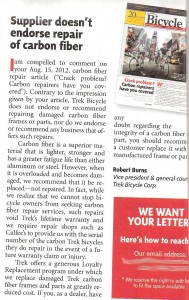This past August, we were one of the companies interviewed by Bicycle Retailer and Industry News about our carbon fiber bicycle repair services. The full article (BRAIN, 8/15/2012, Vol. 21, #14) is located at (opens in a new window): http://www.bicycleretailer.com/2012/08/14/mag-crack-problem. In the next issue, Trek’s Vice President & General Counsel sent a letter stating Trek is against repairing carbon fiber.
This is his letter taken from BRAIN’s 10/1/2012 Vol. 21, #16 issue on page 6:
I am compelled to comment on your Aug. 15, 2012, carbon fiber repair article (“Crack problem? Carbon repairers have you covered”). Contrary to the impression given by your article, Trek Bicycle does not endorse or recommend repairing carbon fiber frames or parts, nor do we endorse or recommend any business that offers such repairs.
Carbon fiber is a superior material that is lighter, stronger, and has a greater fatigue life than either aluminum or steel. However, when it is overloaded and becomes damaged, we recommend that it be replaced – not repaired. In fact, while we realize that we cannot stop bicycle owners from seeking carbon fiber repair services, such repairs void Trek’s lifetime warranty and we require shops such as Calfee’s to provided us with the serial number of the carbon Trek bicycles they do repair in the event of a future warranty claim or injury.
Trek offers a generous Loyalty Replacement program under which we replace damaged Trek carbon fiber frames and parts at a greatly reduced cost. If you, as a dealer, have any doubt regarding the integrity of a carbon fiber frame or part, you should recommend that a customer replace it with a newly manufactured frame or part.
-Robert Burns, Vice president & general counsel, Trek Bicycle Corp.
Here is our response that we submitted to BRAIN:
In response to Mr. Burns’ statements in “Supplier doesn’t endorse repair of carbon fiber”, conclusions were made that do not accurately represent the work we do nor give carbon fiber the credit it deserves.
We’re headquartered in Jacksonville, North Carolina, which is home to Camp Lejeune, the largest Marine base on the East Coast. The military is no stranger to working with composites. Carbon fiber specialists are everywhere on military installations. Why? Because carbon repair is constantly being done on equipment, vehicles, and air craft. If it’s safe in combat and flight situations, it’s safe in riding situations.
To address the warranty concern — There isn’t one. We’re not voiding any manufacturer’s warranty. We always recommend that problems from warranty defects be brought to the manufacturer. Our repairs are on non-warranty breaks caused by customers (crashing, bikes falling over, over torquing, etc.). Carbon repairs can be so well done that the manufacturer might not be able to tell if the frame was repaired and needs to protect itself from fraudulent warranty claims.
Ask yourself these questions: Do airline companies have to buy new planes from Boeing when there is damage to a section like a wing? Do you have to buy a new McLaren if you damage part of it? (It’s well documented here: http://www.compositesworld.com/articles/automotive-cfrp-repair-or-replace) If a fuselage can be repaired, a bike can. When a carbon fiber part on a glider breaks, is the user supposed to replace the entire glider?
A Couple of Points to Remember in Guiding your Customers:
Seek out the Professionals, not a Weekend Repair Warrior
- YouTube isn’t the answer
- You can find videos of people repairing their bikes and too many are wrong
- A lot of people don’t know what they’re doing
- Use Companies that have Engineers and Experts
- Engineers and tool and die makers know what needs to be done.
- There are companies that have decades of experience.
Acknowledge other Industries
- Aerospace, military, automotive industries all take advantage of carbon’s repairability. Why can’t the bicycle industry?
Understand what’s Practical
- We whole heartedly agree with Mr. Burns that certain parts should not be repaired. Forks, stems, cranks, handlebars should always be replaced. It’s more cost effective to purchase new parts.
Until crash replacement programs become more economically comparable to repairs, we’re going to keep repairing carbon fiber. Don’t get us wrong, there are times when we recommend customers purchase a crash replacement over a repair. It’s because the frame is totaled or cost prohibitive.
A bike shop that wants to show its customers it has their interests as a top priority presents all options. The bike manufacturer doesn’t have to face the customer. You, the bike shop do.

